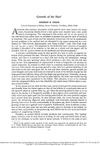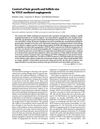TLDR Ber‐EP4 marks cells related to the secondary hair germ in hair follicles.
The study investigated the expression of Ber-EP4 antigen in human hair follicles at different stages of the hair cycle. Ber-EP4 was found to be positively stained in the lower part of the epithelial strand of late catagen hair follicles, the secondary hair germ of telogen hair follicles, and the matrix of early anagen hair follicles, but not in mature anagen hair follicles. This contrasted with keratin 15, which was expressed in specific parts of anagen, catagen, and telogen hair follicles, and keratin 19, which had overlapping expression with keratin 15. The findings suggested that Ber-EP4 is a marker for the secondary hair germ and possibly a related cell population, but not for the presumptive stem cell population indicated by keratin 15 or keratin 19.
87 citations
,
February 2000 in “Journal of Investigative Dermatology” Stem cells in developing hair follicles move to specific areas as they mature.
 50 citations
,
August 1999 in “Experimental dermatology”
50 citations
,
August 1999 in “Experimental dermatology” The control system for hair growth cycles is not well understood and needs more research.
198 citations
,
March 1999 in “Journal of Investigative Dermatology” 441 citations
,
May 1996 in “Journal of Cell Science” Keratin 19 helps identify skin stem cells, with its presence varying by body location, age, and culture stage.
 521 citations
,
January 1954 in “Physiological Reviews”
521 citations
,
January 1954 in “Physiological Reviews” Hair growth is cyclic and influenced mainly by local factors.
 October 2021 in “Research Square (Research Square)”
October 2021 in “Research Square (Research Square)” Hair follicle stem cells in hairpoor mice are disrupted, causing hair loss.
95 citations
,
July 2006 in “British Journal of Dermatology” Vitamin D receptors in hair follicles change with the hair cycle, affecting hair growth.
45 citations
,
April 2001 in “The journal of investigative dermatology/Journal of investigative dermatology” Different Myc family proteins are located in various parts of the hair follicle and may affect stem cell behavior.
 520 citations
,
February 2001 in “Journal of Clinical Investigation”
520 citations
,
February 2001 in “Journal of Clinical Investigation” VEGF helps hair grow and determines follicle size by increasing blood vessel growth.
10 citations
,
October 2000 in “PubMed” E6/E7 oncogenes in hair follicles cause continuous hair growth by skipping the resting phase.



